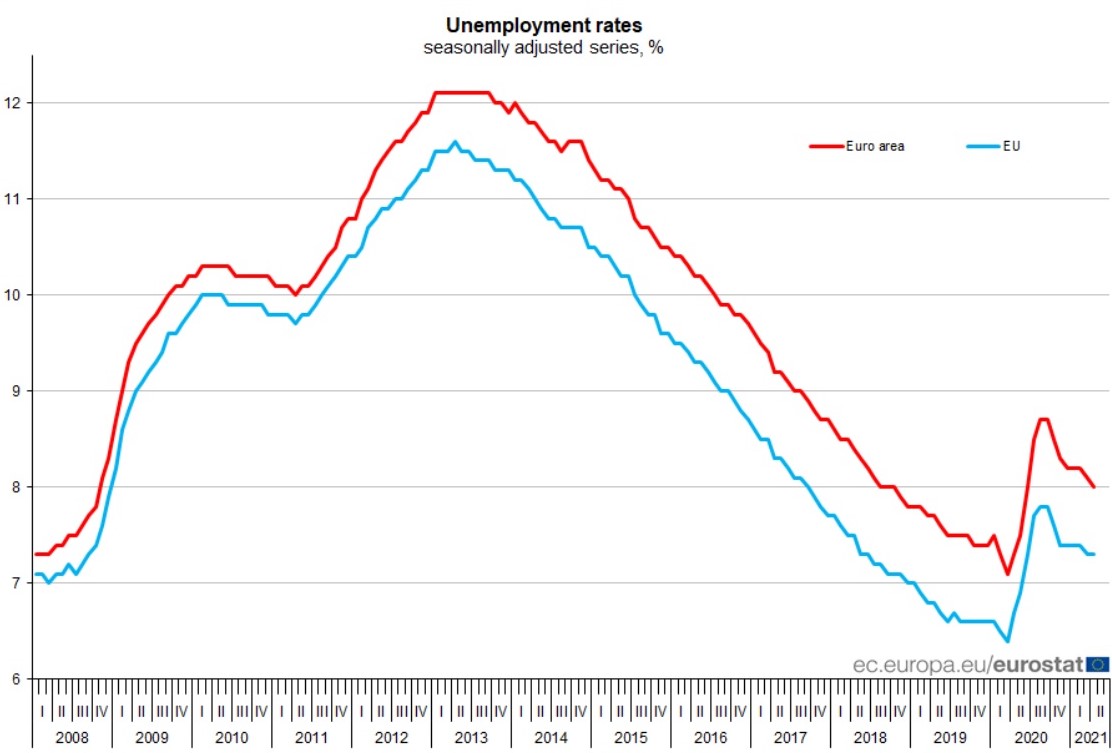News
01 June 2021 |News
April 2021: Euro area unemployment at 8.0%, EU at 7.3%

April2021: Euro area unemployment at8.0% (Illustration: Eurostat)
In April 2021, the euro areaseasonally-adjusted unemployment rate was 8.0%, down from 8.1% in March 2021 and up from 7.3% in April 2020. The EU unemployment rate was 7.3% in April 2021, stable compared with March 2021and up from 6.7% in April 2020.These figures are published by Eurostat, the statistical office of the European Union.
Eurostat estimates that 15.380 million men and women in the EU, of whom 13.030 million in the euro area, were unemployed in April 2021. Compared with March2021, the number of persons unemployed decreasedby 165000 in the EUandby 134000 in the euro area.Compared with April2020, unemployment rose by 1.406 million in the EUand by 1.275 million in the euro area.
Youth unemployment
In April 2021, 2.939 million young persons (under 25) were unemployed in the EU, of whom 2.348 million were in the euro area. In April 2021, the youth unemployment rate was 17.1% in the EU and 17.2% in the euro area, stable in both areas compared with the previous month. Compared with March 2021, youth unemployment decreased by 21 000 in the EU and by 18 000 in the euro area. Compared with April 2020, youth unemployment increased by 211 000 in the EU and by 126 000 in the euro area.
Unemployment by gender
In April2021, the unemployment rate for women was 7.6%in the EU, down from 7.7% in March 2021. The unemployment rate for men was 7.0% in April 2021, stable compared with March 2021.In theeuro area,the unemployment rate for women decreased from 8.5% in March 2021 to 8.4% in April 2021 while the unemployment rate for men remained stable at 7.7%.
Additional labour market indicators
These estimates are based on the globally used International Labour Organisation(ILO) standard definition of unemployment, which counts as unemployed people without a job who have been actively seeking work in the last four weeks and are available to start work within the next two weeks. The COVID-19 outbreak and the measures applied to combat it have triggered a sharp increase in the number of claims for unemployment benefits across the EU. At the same time, a significant part of those who had registered in unemployment agencies were no longer actively looking for a jobor no longer available for work, for instance,if they had to take care of their children. This leads to discrepancies in the number of registered unemployed and those measured as unemployed according to the ILO definition. To capture in full the unprecedented labour market situation triggered by the COVID-19 outbreak, the data on unemployment have been complemented by additional indicators, e.g. underemployed part-time workers, persons seeking work but not immediately available and persons available to work but not seeking, released together with LFS data for the fourth quarter of 2020.
Source: ec.europa.eu/eurostat/





